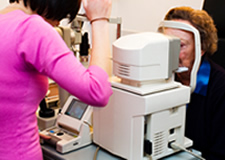Medical Services
Corneal Exams
 The cornea is the clear covering of the front of the eye that bends, or refracts, light rays as they enter the eye. For clear vision to occur, the cornea must have the correct shape and clarity to focus incoming light rays precisely on the retina at the back of the eye.
The cornea is the clear covering of the front of the eye that bends, or refracts, light rays as they enter the eye. For clear vision to occur, the cornea must have the correct shape and clarity to focus incoming light rays precisely on the retina at the back of the eye.
Corneal exams are important because they can determine whether any distortions exist in this portion of the eye. A computerized test called corneal topography can map out the surface of the cornea, alerting your doctor to the presence of inflammation, scarring or astigmatism. This exam can provide information about the health of the cornea and is a valuable diagnostic tool prior to a contact lens fitting, vision correction procedure or corneal transplant.
Diabetic Eye Care
Patients with diabetes are at an increased risk of developing eye diseases that can lead to vision loss and blindness, such as diabetic retinopathy, cataracts and glaucoma. In fact, diabetes is actually the leading cause of blindness in the United States.
Diabetic eye conditions often develop without any noticeable vision loss or pain, so significant damage may already be done to the eye by the time patients notice any symptoms. For this reason, it is important for diabetic patients to have their eyes examined at least once a year. Early detection of eye disease can help prevent permanent damage.
Diabetic-related eye problems develop from high blood sugar levels, which can cause damage to blood vessels in the eye. More than 40 percent of those with diabetes will develop some form of eye disease in their life. The risk of developing eye problems can be reduced through regular eye exams and by keeping blood sugar levels under control through a healthy diet and regular exercise.
Dry Eye Disease Management
The feeling of dry eyes is often caused by a problem in the eye’s tears. The tear problems can be caused by the environment, drugs or health conditions. Low humidity, wind (sleeping with a fan or sleep apnea mask), allergens and smoke are environmental factors that can cause problems with your tears.
Low humidity indoors is usually caused by extremes of temperatures outdoors. Even with a humidifier, we typically run heat or air conditioning more in extreme conditions, causing our knuckles to split, lips to crack and eyes to sting and burn. Other low-humidity environments include airplanes and large buildings, such as shopping malls, office buildings and hospitals. Sleep apnea masks are common offenders, even if they fit well. Even a small amount of air leaking from a mask can dry the eyes through the tiny space between your eyelids. Allergens and smoke also cause tears to evaporate more quickly.
Drugs that often cause dry eye include:
- sedatives like Benadryl, sleep aids, cold remedies or anxiety pills
- allergy pills
- blood pressure medications
- medicated eye drops like glaucoma drops, Visine, Similasan or other drops with preservatives in them
Your ophthalmologist can help you identify medicines that could be causing your symptoms.
Health conditions that can cause dry eye include:
- diabetes
- thyroid dysfunction
- rheumatoid arthritis
- Parkinson’s disease
- rosacea
- previous eye surgery
Finally, any visually intensive task such as reading a book, staring at a computer or watching TV causes you to blink less often. Blinking less leads to eye strain and dry eyes.
There are things you can do to help with dry eye:
- For every hour of reading or watching TV, take a break and look away from the screen for at least 20 seconds. Blink frequently and consider using lubricant eye drops like Refresh, Systane, Soothe or Blink. Avoid any eye drops with a redness reliever or allergy component like Visine, Similasan or Naphcon A.
- If you must sleep with a fan on or other moving air, use a gel drop or eye ointment. These treatments will help keep your eyes moist overnight.
- Add walnuts and fish such as salmon to your diet. Both contain omega-3 fatty acids that help make the oily tear layer more like oil instead of shortening. The more fluid the layer is, the better it spreads across the top of the tears, preventing evaporation. If you are allergic to nuts or don’t love fish, try a fish oil supplement instead.
- If symptoms persist, see an ophthalmologist. Ophthalmologists are doctors trained to medically and surgically treat eye disease. They will perform a full medical history and comprehensive eye exam to determine all the contributing factors to dry eye syndrome and will prescribe treatment. Here’s a rundown of several new therapies for dry eye.
- Be patient with your body. Dry eye cannot be cured like pink eye with a course of antibiotic drops. It is a chronic condition requiring lifestyle changes and often medical treatment to maintain the best possible eye condition.
Thyroid Eye Disease Care
Hyperthyroidism, also known as an overactive thyroid gland, involves an excess of hormone production that can lead to weight loss, irregular heartbeat and irritability. One of the most common reasons for an overactive thyroid gland is Graves’ disease, an autoimmune disorder in which antibodies cause the thyroid to produce too much thyroxine.
This condition may cause symptoms within the eyes such as bulging, excess tearing, swollen eyelids and light sensitivity. If symptoms are mild, conservative treatment may be attempted using lubricating eye drops, protective eye coverings and prism lenses. Oral steroids are sometimes prescribed for short-term use to relieve swelling and discomfort.
In more severe cases of thyroid eye disease, surgical treatment may be recommended. Depending upon the way the condition is affecting the eyes, procedures may be considered to relieve the pressure on the optic nerve, reposition the muscles of the eye or alter the eyelid skin and tissue.


